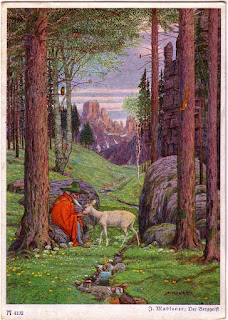From information in her writing we can glean that she was born between 930 and 940CE to a well-to-do Saxon family. We do not know what prompted her to "take the veil" and enter a nunnery, but we know she took vows of chastity and obedience but not poverty, presumable because she did not want to give up comforts and freedoms she had grown up with.
In a preface to her poetical works, she writes of her education at the Abbey of Gandersheim:
I was trained first by our most learned and gentle novice-mistress Rikkarda and others. Later, I owed much to the kind favour and encouragement of a royal personage, Gerberga, under whose abbatial rule I am now living. She, though younger in years than I, was, as might be expected of the niece of an Emperor, far older in learning, and she had the kindness to make me familiar with the works of some of those authors in whose writings she had been instructed by learned men.
Among the works to which she was introduced were those of the Roman playwright Terence, and she decided she wanted to try her hand at that genre, making her the earliest known playwright—female or male—in the Latin West. Where Terence wrote women as shrews and courtesans, Hrotsvitha wrote them as innocents who were exemplars of Christian virtue.
She was the first female poet in Germany, writing several works in dactylic hexameter, including a history of the Ottoman Empire. and a history of Gandersheim Abbey.
She was the first Northern European to write about Islam. In her play Passio Sancti Pelagio ("The Passion of Saint Pelagius"), which she says is derived from an eyewitness to the martyrdom of Pelagius of Cordova, she refers to the character of Abd al-Rahman III, the Emir of Cordova from 929-961. Her plays read as dialogues, which means they are labeled "closet dramas" (a play meant to be read out loud, rather than performed). We know, however, that the Abbey enjoyed her writing, and she was asked to read to the other nuns, so it is possible that her plays were "performed" at Gandersheim.
The discovery and publication (in 1501) of her works made her a subject for study. In the 20th century, she became a feminist icon, which means I'll take a deeper dive into her works tomorrow.






























